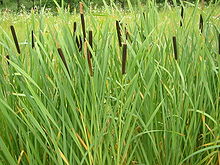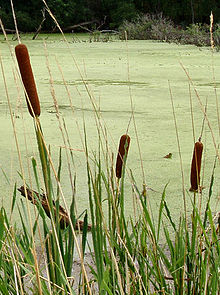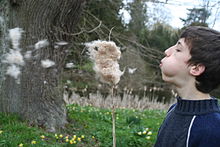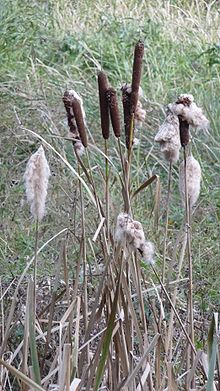- Typha
-
"Typha" 
"Typha latifolia" Scientific classification Kingdom: Plantae (unranked): Angiosperms (unranked): Monocots (unranked): Commelinids Order: Poales Family: Typhaceae Genus: Typha
L.Species See text
Cattail, narrow leaf shoots Nutritional value per 100 g (3.5 oz) Energy 106 kJ (25 kcal) Carbohydrates 5.14 g - Sugars 0.22 g - Dietary fiber 4.5 g Fat 0.00 g Protein 1.18 g Water 92.65 g Vitamin A equiv. 1 μg (0%) - beta-carotene 6 μg (0%) Thiamine (vit. B1) 0.023 mg (2%) Riboflavin (vit. B2) 0.025 mg (2%) Niacin (vit. B3) 0.440 mg (3%) Pantothenic acid (B5) 0.234 mg (5%) Vitamin B6 0.123 mg (9%) Folate (vit. B9) 3 μg (1%) Choline 23.7 mg (5%) Vitamin C 0.7 mg (1%) Vitamin K 22.8 μg (22%) Calcium 54 mg (5%) Iron 0.91 mg (7%) Magnesium 63 mg (18%) Manganese 0.760 mg (36%) Phosphorus 45 mg (6%) Potassium 309 mg (7%) Sodium 109 mg (7%) Zinc 0.24 mg (3%) Percentages are relative to US recommendations for adults.
Source: USDA Nutrient DatabaseTypha (
 /ˈtaɪfə/) is a genus of about eleven species of monocotyledonous flowering plants in the family Typhaceae. The genus has a largely Northern Hemisphere distribution, but is essentially cosmopolitan, being found in a variety of wetland habitats. These plants are known in British English as bulrush, bullrush, or reedmace,[1] in American English as cattail, catninetail, punks, or corndog grass, in Australia as cumbungi or bulrush, and in New Zealand as raupo. Typha should not be confused with other plants known as bulrush, such as some sedges (mostly in Scirpus and related genera).
/ˈtaɪfə/) is a genus of about eleven species of monocotyledonous flowering plants in the family Typhaceae. The genus has a largely Northern Hemisphere distribution, but is essentially cosmopolitan, being found in a variety of wetland habitats. These plants are known in British English as bulrush, bullrush, or reedmace,[1] in American English as cattail, catninetail, punks, or corndog grass, in Australia as cumbungi or bulrush, and in New Zealand as raupo. Typha should not be confused with other plants known as bulrush, such as some sedges (mostly in Scirpus and related genera).Their rhizomes are edible. Evidence of preserved starch grains on grinding stones suggests they were eaten in Europe 30,000 years ago.[2]
Contents
Description
Typha leaves are alternate and mostly basal to a simple, jointless stem that eventually bears the flowering spikes. The rhizomes spread horizontally beneath the surface of muddy ground to start new upright growth, and the spread of Typha is an important part of the process of open water bodies being converted to vegetated marshland and eventually dry land.
Typha plants are monoecious and bear unisexual, wind-pollinated flowers, developing in dense spikes. The numerous male flowers form a narrow spike at the top of the vertical stem. Each male (staminate) flower is reduced to a pair of stamens and hairs, and withers once the pollen is shed. The very large numbers of tiny female flowers form a dense, sausage-shaped spike on the stem below the male spike — in larger species this can be up to 30 centimetres (12 in) long and 1 to 4 centimetres (0.39 to 1.6 in) thick. Seeds are minute, 0.2 millimetres (0.0079 in) long, and attached to a fine hair. When ripe the heads disintegrate into dense cottony fluff, from which the seeds disperse by wind. Typha is often among the first wetland plants to colonize areas of newly exposed wet mud; it also spreads by rhizomes, forming dense stands often to the exclusion of other plants.
Species
- Typha angustifolia - Lesser Bulrush, Narrow Leaf Cattail (America) or Jambu (India)
- Typha domingensis - Bulrush, Southern Cattail (America) or Narrow-leaved Cumbungi (Australia)
- Typha × glauca (angustifolia × latifolia) - Hybrid or White Cattail. Sterile hybrid.[3]
- Typha latifolia - Common Cattail
- Typha laxmannii - Laxman's Bulrush
- Typha minima - Dwarf Bulrush
- Typha muelleri - Raupo (New Zealand)
- Typha orientalis - Broadleaf Cumbungi (Australia) or Raupo (New Zealand)
- Typha capensis - Cape bulrush
- Typha shuttleworthii - Shuttleworth's Bulrush
The most widespread species is Typha latifolia, extending across the entire temperate northern hemisphere. T. angustifolia is nearly as widespread, but does not extend so far north; some believe it is introduced and invasive in North America. T. domingensis is a more southerly American and Australian species, extending from the U.S. to South America. T. orientalis is widespread in eastern & northern Australia, temperate & tropical Asia, New Zealand. T. laxmannii, T. minima, and T. shuttleworthii are largely restricted to Asia and parts of southern Europe. Typha latifolia has also been recently introduced into fresh water creeks and lakes in Australia where the water is shallow and contains levels of dirty, turbid water. It affects the flow of the water and also filters the water and catches floating or submerged items, possibly damming the water flow.
Typha plants grow along lake margins and in marshes, often in dense colonies, and are sometimes considered a weed in managed wetlands. The plant's root systems help prevent erosion, and the plants themselves are often home to many insects, birds and amphibians.
Uses
Culinary uses
Typha has a wide variety of parts that are edible to humans. The rhizomes, underground lateral stems, are a pleasant nutritious and energy-rich food source that when processed into flour contains 266 kcal per 100 g.[2] They are generally harvested from late autumn to early spring. These are starchy, but also fibrous, so the starch must be scraped or sucked from the tough fibers. The bases of the leaves can be eaten raw or cooked, in late spring when they are young and tender.[4] In early summer the sheath can be removed from the developing green flower spike which can than be boiled and eaten like corn on the cob.[5] In mid-summer, once the male flowers are mature,[6] the pollen can be collected and used as a flour supplement or thickener.[7] Typha has also recently been suggested as a source of oil.[clarification needed] However, the plant's airborne seeds have also been known to create skin irritation and can trigger asthma.
Starch grains have been found on grinding stones widely across Europe from 30,000 BP suggesting that Typha plants were a widely used Upper Paleolithic food.[2]
Other uses
The disintegrating heads are used by some birds to line their nests. The downy material was also used by some Native American tribes as tinder for starting fires.
Some Native American tribes also used Typha down to line moccasins, and for bedding, diapers, baby powder, and papoose boards. One Native American word for Typha meant "fruit for papoose's bed". Today some people still use Typha down to stuff clothing items and pillows.[8] When using Typha for pillow stuffing, dense batting material is used, as the fluff may cause a skin reaction similar to urticaria.
Typha can be dipped in wax or fat and then lit as a candle, the stem serving as a wick. It can also be lit without the use of wax or fat, and it will smolder slowly, somewhat like incense, and may repel insects.
The down has been used to fill life vests in the same manner as kapok.[citation needed]
Typha can be used as a source of starch to produce ethanol, instead of cereals. They have the advantage that they do not require much, if any, maintenance.[9]
One informal experiment has indicated that Typha is able to remove the poisonous element arsenic from drinking water. Such a filtration system may be one way to provide cheap water filtration for people in developing nations.[10]
The boiled rootstocks have been used as a diuretic for increasing urination, or used mashed to make a jelly-like paste for sores, boils, wounds, burns, scabs, and smallpox pustules.[citation needed]
Typha orientalis is used to make compostable food packaging.[11]
References
- ^ Collins Complete British Wildlife
- ^ a b c Revedin, A; Aranguren, B; Becattini, R; Longo, L; Marconi, E; Lippi, MM; Skakun, N; Sinitsyn, A et al. (2010). "Thirty thousand-year-old evidence of plant food processing". Proc Natl Acad Sci U S A 107: 18815–18819. Bibcode 2010PNAS..10718815R. doi:10.1073/pnas.1006993107. PMC 2973873. PMID 20956317. http://www.pubmedcentral.nih.gov/articlerender.fcgi?tool=pmcentrez&artid=2973873.
- ^ Selbo, Sarena M.; Snow, Allison A. (2004). "The potential for hybridization between Typha angustifolia and Typha latifolia in a constructed wetland". Aquatic Biology 78: 361–369. doi:10.1016/j.aquabot.2004.01.003. http://www.biosci.ohio-state.edu/~asnowlab/SelboSnowAqBot04.pdf.
- ^ "Flavors of Spring". Silvercrown Mountain Outdoor School. http://www.exploresmos.org/outdoor-skills/flavors-spring/. Retrieved 25 March 2011.
- ^ Elias, Thomas S.; Dykeman, Peter A. (2009) [1982]. Edible Wild Plants. New York, NY: Sterling Publishing Co., Inc.. pp. 69–70. ISBN 9781402767159.
- ^ Lee Allen Peterson, Edible Wild Plants
- ^ [1]
- ^ http://www.cattails.wordpress.com
- ^ Heldreth, David (August 11, 2008). "Cattails can be Ethanol Source". Blue Mountain Eagle (Grant County, Oregon). http://replay.waybackmachine.org/20090208180246/http://bioenergy.checkbiotech.org/news/cattails_can_be_ethanol_source. Retrieved 2008-08-21.
- ^ "Inexpensive Arsenic Filtration System Based on Cattails Could Help Clean Up the Drinking Water of 57 Million People". http://www.treehugger.com/files/2009/07/inexpensive-arsenic-water-filtration-system-cheap-cattails.php.
- ^ "Be Green Packaging press kit". http://www.begreenpackaging.com/pdf/BGP_PressKit09-LO.pdf.
External links
Categories:- Typhaceae
- Poales genera
- Root vegetables
- Inflorescence vegetables
Wikimedia Foundation. 2010.



